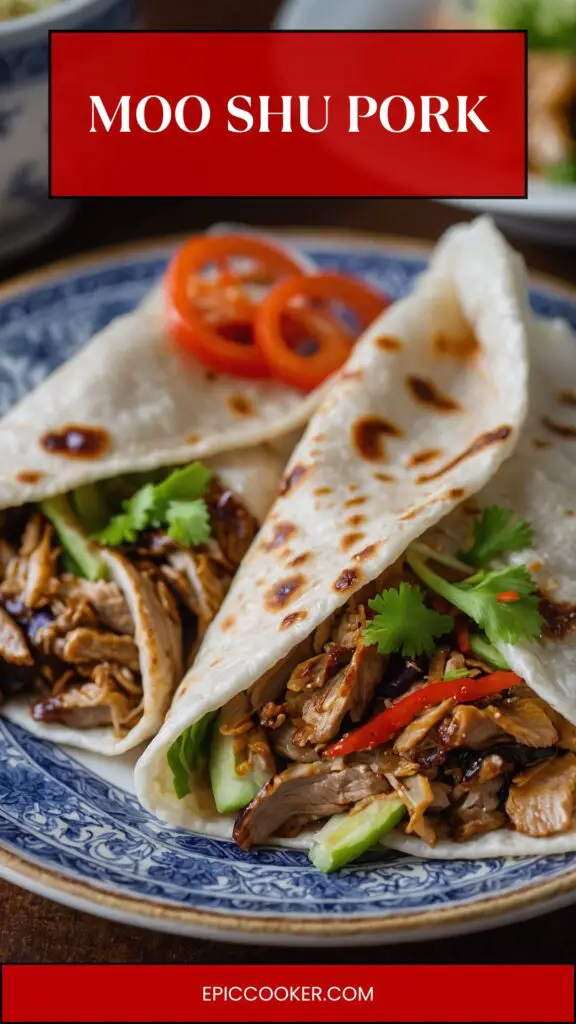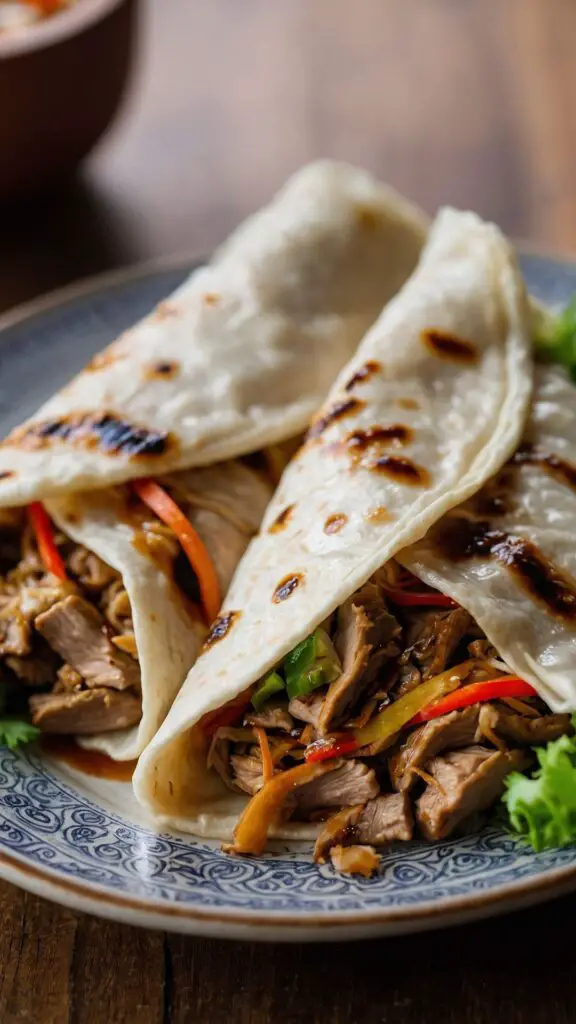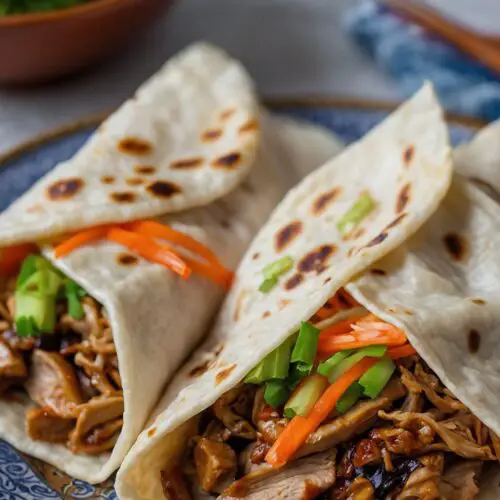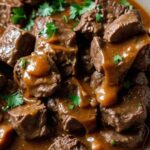When it comes to delicious dining options, few dishes can hold a candle to the exhilarating experience of Moo Shu Pork. This remarkable dish brings together vibrant flavors, textures, and aromas, making it a favorite at Chinese restaurants across the globe. However, to truly appreciate Moo Shu Pork, one must understand what pairs well with it.
Serving it alongside light jasmine rice or refreshing cucumber salad enhances the flavors, creating a delightful balance on your plate.
Now, let’s dive into the enchanting story behind Moo Shu Pork.

What Is Moo Shu Pork?
Moo Shu Pork is a traditional Chinese dish that originated from the Shandong province. It traditionally features tender slices of pork stir-fried with an array of colorful vegetables, often encapsulated in thin pancakes. The dish is usually served with a sweet and savory hoisin sauce, which adds a wonderful layer of depth to every bite.
Imagine the sizzle of the pork hitting the hot wok, infusing the kitchen with an irresistible aroma. Each ingredient tells a story, conveying the rich culinary heritage from which it came. The dish encapsulates both comfort and sophistication, making it a staple in many Chinese restaurants.
What Is the Flavor Profile of This Dish?
Moo Shu Pork is a delightful medley of flavors. The pork is savory and slightly sweet, bolstered by the rich umami character of the hoisin sauce. The fresh vegetables, including cabbage, carrots, and bell peppers, contribute a crisp texture and vibrant flavor that balances the dish. The mingling of garlic and ginger adds warmth, while scallions provide a mild onion-like sweet note.
This harmony between savory, sweet, and crisp elements makes every bite a delightful experience, invoking harmony and satisfaction. Furthermore, each component is thoughtfully sliced and prepared to maintain its individual flavors, yet they create a cohesive dish when combined.
What Makes This Recipe Different from Other Moo Shu Pork?
While many recipes share similar core ingredients, my version of Moo Shu Pork stands out. This recipe combines traditional flavors with fresh ingredients and simple preparation methods. I emphasize using high-quality hoisin sauce for that rich, sweet flavor, and fresh vegetables for added nutrition and crunch.
Unlike some variations that may overdo the sauce or skimp on the vegetables, my recipe achieves a perfect balance. Every element works harmoniously, allowing the flavors to shine individually while embracing the ensemble. Additionally, I incorporate unique aspects like toasted sesame oil for an added layer of depth, offering a memorable experience on the palate.
You will also like the following Lunch recipes!
Ingredients You’ll Need
To recreate this satisfying dish, here’s a comprehensive list of what you’ll need:
Assembly
- 1/2 cup hoisin sauce (8 tablespoons; 1 for each pancake)
- Cilantro leaves for garnish (optional)
- 8 classic moo shu pancakes
Vegetables
- 1 cucumber (halved lengthwise and sliced on the bias; optional)
- 1/2 red bell pepper (thinly sliced; adds sweetness and color)
- 1 cup carrots (grated or julienned)
- 4 scallions (sliced diagonally at a 45° angle)
- 2 cups green cabbage (finely shredded)
- 20 dried golden lily buds (optional)
- 1 ounce dried black wood ear mushrooms (or 8 dried shiitake mushrooms)
Sauce
- 1 teaspoon cornstarch
- 1 teaspoon soy sauce
- 1/4 cup low-sodium chicken broth
- 1 tablespoon oyster sauce
- 1/2 teaspoon toasted sesame oil
Pork / Marinade
- 1 tablespoon Shaoxing rice wine (or dry sherry)
- 1/2 teaspoon ground white pepper
- 1 teaspoon toasted sesame seeds (adds nutty aroma and subtle crunch)
- 3 cloves garlic (finely minced)
- 1 teaspoon light soy sauce (or regular soy sauce)
- 1 tablespoon fresh ginger (finely minced)
- 8 ounces pork (sliced into thin julienne strips; see Note 1)
- 1 teaspoon cornstarch
Eggs
- 2 tablespoons neutral oil (like canola or vegetable oil)
- 3 eggs (lightly beaten)

Step-by-Step Directions
Now, let’s embark on the journey of making this delectable dish. Follow these simple yet detailed steps to create your very own Moo Shu Pork.
Step 1: Prepare the Ingredients
Begin by preparing all your ingredients. Thinly slice the pork and combine it in a bowl with the Shaoxing rice wine, light soy sauce, cornstarch, and white pepper. Allow the mixture to marinate for about 15–20 minutes. This will enhance the flavor of the pork and ensure tenderness.
Step 2: Prepare the Vegetables
While the pork is marinating, wash and chop the vegetables. Make sure to julienne the carrots and thinly slice the bell pepper and scallions. Finely shred the cabbage. If you have dried mushrooms, soak them in warm water for about 30 minutes to rehydrate. After soaking, slice them into strips.
Step 3: Cook the Pork
In a large skillet or wok, heat the neutral oil over medium-high heat. Add the marinated pork and stir-fry until the meat is cooked through and slightly browned. This should take about 3–5 minutes. Once cooked, remove the pork from the pan and set it aside.
Step 4: Stir-Fry the Vegetables
In the same skillet, add a bit more oil if necessary. First, add the minced garlic and fresh ginger, sautéing until fragrant. Then, add the carrots, bell pepper, mushrooms, and cabbage. Stir-fry for 3–4 minutes or until the vegetables are slightly tender but still crisp.
Step 5: Combine and Add Sauce
Return the cooked pork to the skillet with the vegetables. Now, pour in the low-sodium chicken broth, oyster sauce, soy sauce, and toasted sesame oil. Stir well to mix everything together. In a small bowl, dissolve cornstarch in a little water and add this to the skillet to thicken the sauce. Cook for 2–3 minutes until everything is heated through and well combined.
Step 6: Add Eggs and Serve
Finally, make a well in the center of the skillet. Pour the lightly beaten eggs into the well, stirring gently to scramble them as they cook. Once the eggs are set, fold them into the rest of the ingredients.
Step 7: Assemble Your Moo Shu Pork
To serve, lay out the moo shu pancakes and place a generous scoop of the Moo Shu Pork mixture onto each one. Drizzle with hoisin sauce and sprinkle with fresh cilantro leaves if desired. Roll it up and enjoy!
Tips on Making Moo Shu Pork
Here are some handy tips to elevate your Moo Shu Pork experience:
Choose Quality Ingredients: Fresh vegetables and high-quality sauces significantly enhance flavor.
Prep Ahead: Have all ingredients ready before you start cooking. This makes the process smooth and prevents overcooking.
Control Oil Usage: Use just enough oil to prevent sticking. Too much can bog down the dish.
Don’t Overcrowd the Pan: Cook in batches if necessary. Overcrowding leads to steaming instead of stir-frying.
Customize as You Wish: Feel free to throw in additional veggies like broccoli or snap peas based on your taste preference.
Nutrition Information
Now, let’s take a quick look at the nutritional benefits of Moo Shu Pork. The approximate nutritional breakdown per serving is:
- Calories: 350
- Protein: 30g
- Carbohydrates: 40g
- Dietary Fiber: 5g
- Fats: 12g
Packed with protein from pork and eggs along with a variety of vitamins from vegetables, this dish can be part of a balanced diet.
How Can I Store This Moo Shu Pork?
After preparing, you might wonder how to store the leftovers. Here’s how:
- Cool Down: Allow the Moo Shu Pork to cool to room temperature.
- Use Airtight Containers: Place the pork and pancakes in separate airtight containers. This prevents sogginess.
- Refrigeration: Store in the fridge and consume within 3–4 days.
- Reheating: Reheat in a pan over low heat to warm thoroughly. You may add a splash of broth to retain moisture.

If the Items Are Not Available in Your Kitchen, What Are Some Substitute Options for the Ingredients?
Sometimes, you may not have all the ingredients on hand. Here are some substitutes to keep your dish on track:
Pork: If you don’t have pork, consider using chicken or tofu for a lighter version. They hold up well with similar flavors.
Hoisin Sauce: Try a mix of soy sauce, sugar, and peanut butter for a DIY hoisin alternative. It may not taste identical, but it’ll work.
Vegetables: If you lack certain vegetables, greens like bok choy or snap peas can work beautifully. They’ll add color and crunch.
Sesame Oil: In the absence of sesame oil, olive oil can be a good substitute. Just remember it will change the flavor slightly.

Moo Shu Pork
Equipment
- skillet
- Bowl
Ingredients
Assembly
- 1/2 cup hoisin sauce 8 tablespoons; 1 for each pancake
- Cilantro leaves for garnish optional
- 8 classic moo shu pancakes
Vegetables
- 1 cucumber halved lengthwise and sliced on the bias; optional
- 1/2 red bell pepper thinly sliced; adds sweetness and color
- 1 cup carrots grated or julienned
- 4 scallions sliced diagonally at a 45° angle
- 2 cups green cabbage finely shredded
- 20 dried golden lily buds optional
- 1 ounce dried black wood ear mushrooms or 8 dried shiitake mushrooms
Sauce
- 1 teaspoon cornstarch
- 1 teaspoon soy sauce
- 1/4 cup low-sodium chicken broth
- 1 tablespoon oyster sauce
- 1/2 teaspoon toasted sesame oil
Pork / Marinade
- 1 tablespoon Shaoxing rice wine or dry sherry
- 1/2 teaspoon ground white pepper
- 1 teaspoon toasted sesame seeds adds nutty aroma and subtle crunch
- 3 cloves garlic finely minced
- 1 teaspoon light soy sauce or regular soy sauce
- 1 tablespoon fresh ginger finely minced
- 8 ounces pork sliced into thin julienne strips; see Note 1
- 1 teaspoon cornstarch
Eggs
- 2 tablespoons neutral oil like canola or vegetable oil
- 3 eggs lightly beaten
Instructions
Step 1: Prepare the Ingredients
- Begin by preparing all your ingredients. Thinly slice the pork and combine it in a bowl with the Shaoxing rice wine, light soy sauce, cornstarch, and white pepper. Allow the mixture to marinate for about 15–20 minutes. This will enhance the flavor of the pork and ensure tenderness.
Step 2: Prepare the Vegetables
- While the pork is marinating, wash and chop the vegetables. Make sure to julienne the carrots and thinly slice the bell pepper and scallions. Finely shred the cabbage. If you have dried mushrooms, soak them in warm water for about 30 minutes to rehydrate. After soaking, slice them into strips.
Step 3: Cook the Pork
- In a large skillet or wok, heat the neutral oil over medium-high heat. Add the marinated pork and stir-fry until the meat is cooked through and slightly browned. This should take about 3–5 minutes. Once cooked, remove the pork from the pan and set it aside.
Step 4: Stir-Fry the Vegetables
- In the same skillet, add a bit more oil if necessary. First, add the minced garlic and fresh ginger, sautéing until fragrant. Then, add the carrots, bell pepper, mushrooms, and cabbage. Stir-fry for 3–4 minutes or until the vegetables are slightly tender but still crisp.
Step 5: Combine and Add Sauce
- Return the cooked pork to the skillet with the vegetables. Now, pour in the low-sodium chicken broth, oyster sauce, soy sauce, and toasted sesame oil. Stir well to mix everything together. In a small bowl, dissolve cornstarch in a little water and add this to the skillet to thicken the sauce. Cook for 2–3 minutes until everything is heated through and well combined.
Step 6: Add Eggs and Serve
- Finally, make a well in the center of the skillet. Pour the lightly beaten eggs into the well, stirring gently to scramble them as they cook. Once the eggs are set, fold them into the rest of the ingredients.
Step 7: Assemble Your Moo Shu Pork
- To serve, lay out the moo shu pancakes and place a generous scoop of the Moo Shu Pork mixture onto each one. Drizzle with hoisin sauce and sprinkle with fresh cilantro leaves if desired. Roll it up and enjoy!
Notes
- Choose Quality Ingredients: Fresh vegetables and high-quality sauces significantly enhance flavor.
- Prep Ahead: Have all ingredients ready before you start cooking. This makes the process smooth and prevents overcooking.
- Control Oil Usage: Use just enough oil to prevent sticking. Too much can bog down the dish.
- Don’t Overcrowd the Pan: Cook in batches if necessary. Overcrowding leads to steaming instead of stir-frying.
- Customize as You Wish: Feel free to throw in additional veggies like broccoli or snap peas based on your taste preference.
Nutrition
Frequently Asked Questions
1. Can I make Moo Shu Pork vegetarian?
Absolutely! Simply swap the pork for extra firm tofu and omit the oyster sauce, using a bit more soy sauce instead
2. How can I make Moo Shu Pork gluten-free?
Use gluten-free soy sauce (look for tamari) and ensure your hoisin sauce is gluten-free. These tweaks make a seamless transition while keeping flavors intact.
3. What sides pair well with Moo Shu Pork?
Light jasmine rice or steamed dumplings make great companions. You could also serve a light cucumber salad on the side for a refreshing crunch.
4. How long does it take to make Moo Shu Pork?
From prep to plate, the entire process takes about 45 minutes. So, it’s a relatively quick meal for weeknights.
5. Can I freeze Moo Shu Pork?
While you can freeze it, the texture may change. It’s better to consume freshly made for optimal taste, but if freezing is necessary, let it cool and use freezer-safe containers.
Conclusion
Moo Shu Pork is not just a dish; it’s an experience. Each flavor burst tells tales of tradition and innovation. As you gather your ingredients and embark on creating this classic dish, remember that it’s about the journey as much as the destination.
So roll up your sleeves, prepare your ingredients, and enjoy this delightful dish. Whether you’re impressing guests at your next gathering or enjoying a quiet night in, Moo Shu Pork is sure to make your taste buds dance. Now go ahead and savor each bite!





